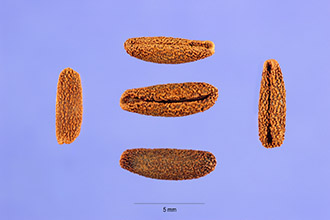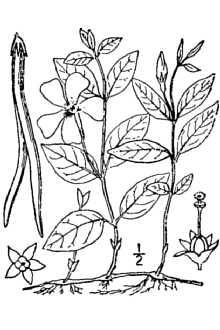Common Periwinkle
Scientific Name: Vinca minor L.

| General Information | |
|---|---|
| Usda Symbol | VIMI2 |
| Group | Dicot |
| Life Cycle | Perennial |
| Growth Habits | Forb/herbVine, |
| Native Locations | VIMI2 |
Plant Guide
Use a soil moisture meter to monitor the soil moisture where Common Periwinkle is planted.
Fact Sheet
Uses
Erosion control: Its use should normally be restricted to partially shaded areas and north or east exposures on ramps and inclines. It should be considered on roadsides in specially adapted locations and sites. Ornamental and beautification: Common periwinkle is particularly desirable as an attractive evergreen ground cover in mild climates. It is valuable on yards, banks, or odd areas as a low maintenance ground cover. It tolerates light traffic but should not be used where frequent trampling occurs.
Status
Please consult the PLANTS Web site and your State Department of Natural Resources for this plant’s current status (e.g. threatened or endangered species, state noxious status, and wetland indicator values).
Description
Vinca minor L., common periwinkle, is a perennial evergreen ground cover that is winter hardy. It is closely related to the big leaf periwinkle (V. major L.), except in size and hardiness. Common periwinkle seldom exceeds a height of 6 inches although runners may trail long distances on the ground. The runners root at the node under moist conditions. The thick glossy leaves form a good ground cover. Small blue flowers occur indeterminately from April to September.
Adaptation and Distribution
Distribution
Distribution
Common periwinkle is adapted to mild climates. It usually requires part shade and ample moisture, but will tolerate full sun if it is adequately watered. It is more hardy than big leaf periwinkle. Moisture and exposure are often more restrictive than soil type on determining adaptation. Common periwinkle is adapted to a wide range of soils. It is found on well drained to poorly drained soils that can be calcareous, alkaline to slightly acidic, and medium textured to fine textured. The plant should be used where there is adequate moisture. Common periwinkle is distributed throughout the East. For a current distribution map, please consult the Plant Profile page for this species on the PLANTS Website. ©William S. Justice Smithsonian Institution @ USD NRCS PLANTS
Establishment
Plants may be established from rooted cuttings produced in flats or from plant division. Plant on a spacing of 18 inches x 18 inches. Fertilizer should be applied for vigorous establishment. Mulch critical areas immediately after planting. Planting can be done any time of the year when moisture is adequate for establishment. This should ordinarily be planted on areas that can be sprinkled or otherwise irrigated or on sites where average annual precipitation is over 20 inches.
Management
Little or no maintenance is required after establishment, Well-established plantings may be clipped to promote new growth, Chemical or mechanical weeding may be need to control unwanted vegetation, Use soil moisture sensors to measure the soil moisture of Common Periwinkle.,
Pests and Potential Problems
Common periwinkle can be affected by blight, canker, leaf spot, and root rot.
Plant Traits
Growth Requirements
| Moisture Use | Low |
|---|---|
| Adapted to Coarse Textured Soils | Yes |
| Adapted to Fine Textured Soils | Yes |
| Adapted to Medium Textured Soils | Yes |
| Anaerobic Tolerance | None |
| CaCO3 Tolerance | Medium |
| Cold Stratification Required | No |
| Drought Tolerance | Medium |
| Fertility Requirement | Medium |
| Fire Tolerance | High |
| Frost Free Days, Minimum | 130 |
| Hedge Tolerance | None |
| pH, Maximum | 7.7 |
| pH, Minimum | 5.5 |
| Planting Density per Acre, Maxim | 19000 |
| Planting Density per Acre, Minim | 2700 |
| Precipitation, Maximum | 60 |
| Precipitation, Minimum | 30 |
| Root Depth, Minimum (inches) | 8 |
| Salinity Tolerance | Low |
| Shade Tolerance | Tolerant |
| Temperature, Minimum (°F) | -33 |
Morphology/Physiology
| Bloat | None |
|---|---|
| Shape and Orientation | Prostrate |
| Toxicity | Moderate |
| Active Growth Period | Spring and Summer |
| C:N Ratio | High |
| Coppice Potential | No |
| Fall Conspicuous | No |
| Fire Resistant | Yes |
| Flower Color | Blue |
| Flower Conspicuous | Yes |
| Foliage Color | Dark Green |
| Foliage Texture | Coarse |
| Growth Form | Stoloniferous |
| Resprout Ability | Yes |
| Nitrogen Fixation | None |
| Low Growing Grass | No |
| Lifespan | Long |
| Leaf Retention | Yes |
| Known Allelopath | No |
| Height, Mature (feet) | 0.3 |
| Growth Rate | Moderate |
| Fruit/Seed Conspicuous | No |
Reproduction
| Vegetative Spread Rate | Moderate |
|---|---|
| Small Grain | No |
| Seed Spread Rate | None |
| Propagated by Bare Root | Yes |
| Propagated by Tubers | No |
| Propagated by Sprigs | No |
| Propagated by Sod | No |
| Propagated by Seed | No |
| Propagated by Corm | No |
| Propagated by Container | Yes |
| Propagated by Bulb | No |
| Fruit/Seed Persistence | No |
| Commercial Availability | Routinely Available |
| Bloom Period | Early Summer |
| Propagated by Cuttings | No |
Suitability/Use
| Veneer Product | No |
|---|---|
| Pulpwood Product | No |
| Protein Potential | Low |
| Post Product | No |
| Palatable Human | No |
| Palatable Graze Animal | Low |
| Palatable Browse Animal | Low |
| Nursery Stock Product | Yes |
| Naval Store Product | No |
| Lumber Product | No |
| Fodder Product | No |
| Christmas Tree Product | No |
| Berry/Nut/Seed Product | No |

